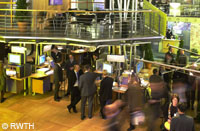EU project reveals a new approach to demonstrations at CeBIT
An EU-funded project has allowed visitors to the CeBIT technology fair in Hanover, Germany, to see into the future of educational presentations and product demonstrations using its mobile Augmented Reality (AR) system. The CONNECT project devised the AR system as part of its overall goal to 'design the classroom of tomorrow by using advanced technologies to connect formal and informal learning environments'. The system allows invisible scientific phenomena to be explained more clearly by adding an extra dimension to visual presentations. 'We are investigating ways in which augmented reality can assist the learning process, both in schools and in museums,' explained Michael Wittkämper, project coordinator from the Fraunhofer Institute for Applied Information Technology (FIT). 'Our technology can be used in other areas too, though - for instance to explain products at trade fairs, or as an aid to vocational training and professional development.' The system being demonstrated at CeBIT shows visitors the physics behind how an aircraft wing allows a plane weighing 550 tonnes to fly. Subjects don a headset with translucent goggles, built-in cameras and a microphone and loudspeakers, which are connected to a mobile computer. When they look through the goggles, the viewer not only sees the wing of the aircraft itself, but also red lines representing the flow of air over it. Three-dimensional images, graphics, text and films that appear to the user to be hovering in mid air help to further explain the invisible physical processes at work. 'The students are fascinated by the technology,' says Kay Hoeksema, a teacher and scientist from the University of Duisburg-Essen and member of the consortium. 'They can hardly believe their eyes when they see the air flow lines in 3D, looking real enough to touch.' She explains that teachers can use a content management system to tailor the subject matter to the needs or existing knowledge of their students, and that extra images, text or audio files can be added via a web interface to the CONNECT platform. And by logging on over the Internet, it is possible for students in a classroom to follow live video streams of experiments or demonstrations being carried out in a laboratory or museum, with a radio link allowing them to ask questions and participate interactively. The consortium is creating AR exhibitions in four museums in different countries in order to develop learning scenarios and carry out field trials with classes of students. Via the CONNECT platform, it will be possible to make a virtual visit to the four exhibits (in the UK, Sweden, Finland and Greece) by the end of this year. The project is receiving 4.7 million euro over three years from the information society technologies (IST) priority of the Sixth Framework Programme (FP6). The consortium is made up of partners from Germany, the UK, Finland, Greece, Portugal, Sweden, Israel and the United States.
Countries
Germany, Greece, Finland, Israel, Portugal, Sweden, United Kingdom, United States



